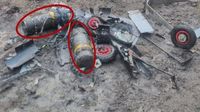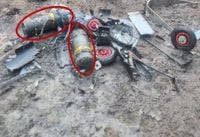In a dramatic escalation of tensions between India and Pakistan, the latter launched over 500 low-cost drones into Indian airspace on the night of May 8-9, 2025. This unprecedented offensive targeted 36 military and strategic locations stretching from Leh in Ladakh to Sir Creek in Gujarat. Although most of these drones were unarmed and easily intercepted, military analysts suggest that the operation was far from simplistic. It appears to be a calculated maneuver designed to exhaust Indian air defense resources, probe vulnerabilities, and potentially map radar coverage and response times.
According to BharatShakti, a senior military official stated, "This was not just an airspace intrusion — it was a calculated move to stress-test our defenses, force resource expenditure, and gather data." The method bears a striking resemblance to Russia’s strategy of deploying Iranian-made Shahed drones in Ukraine, which are often launched in waves to overwhelm Western-supplied air defense systems. Pakistan has seemingly adapted this model, utilizing Chinese commercial-grade or locally modified drones, including Turkish-made Asisguard Songar UAVs, in coordinated salvos across key Indian military hubs such as Jammu, Srinagar, Pathankot, Amritsar, Bhatinda, Adampur, and even as far south as Bhuj and Sir Creek.
These drone swarms included small quadcopters, larger UAVs, and mother drones guiding clusters in organized waves. Forensic examinations revealed that many of the drones carried no explosives, merely stone pellets or empty casings, indicating that the incursion was likely intended for reconnaissance and electronic probing rather than direct strikes. A defense source elaborated, "Pakistan likely wanted us to activate and expose our air defense architecture — radar positions, engagement zones, and response tactics. It’s a tactic to gather critical data for future escalations."
Colonel Sofiya Qureshi confirmed that the drones were accompanied by intense shelling at 20 locations along the Line of Control (LoC). "This was a coordinated hybrid offensive. Our forces responded with both kinetic and non-kinetic capabilities to neutralize the threat," she stated in a press briefing on Friday.
In response, India deployed a variety of systems, including L-70 and ZU-23mm guns, Schilka platforms, and DRDO’s electronic warfare suites, successfully shooting down or disabling more than 70 drones (20 ‘soft’ and 50 ‘hard’ kills). Some drones, however, managed to evade interception and returned to Pakistani territory. One official bluntly summarized the situation: "They’re using Rs 10,000 drones to trigger Rs 2 crore responses. It’s economic warfare." Eyewitnesses across the western corridor reported flashes of light, sonic bursts, and low-flying objects, which led to panic in civilian areas. In urban centers like Ludhiana and Jalandhar, air raid sirens were briefly activated, and in Jammu, there were blackouts for hours.
While most drones were neutralized before reaching sensitive zones, some caused minor infrastructure damage, and at least one military installation was targeted near Awantipora. The situation escalated further when Pakistan launched artillery and mortar attacks along the LoC, resulting in the deaths of two Indian civilians and injuring three, bringing the total death toll to 18 since the escalation began earlier in the week. Foreign Secretary Vikram Misri highlighted the tragic loss of two schoolchildren in Machil, where a shell landed near a primary school, and damage to a Christian convent in the region. "These are not just military provocations. These are attacks on civilian lives and places of worship," he asserted.
In retaliation, Indian armed drones struck multiple Pakistani military positions, reportedly disabling an air defense radar in Lahore. Furthermore, India lodged strong diplomatic protests and suspended operations at the Kartarpur Corridor, citing security concerns. Indian officials also shared flight tracking data indicating that Pakistan had kept its civilian airspace open during the operation — a move interpreted as an attempt to use civilian aircraft as cover during hostile operations. "This is a dangerous and cynical ploy. Pakistan not only violated Indian airspace but also international aviation norms," said Colonel Qureshi.
This drone offensive marks a potential doctrinal shift in Pakistan’s approach: moving from conventional cross-border skirmishes to technologically enabled, low-cost asymmetric warfare aimed at surveillance, disruption, and strategic messaging. India’s defense establishment has taken note of this shift. "This is a wake-up call," stated one official. "The battlefield is evolving, and so must our countermeasures — in speed, scale, and strategy."
In a related incident, the Indian Army reported that multiple Byker YIHA III kamikaze drones were launched by Pakistan towards Amritsar in Punjab early on May 10, 2025, at approximately 5:00 a.m. These drones were quickly shot down by the Army's Air Defence units. The Indian Army's Additional Directorate General of Public Information (ADGPI) condemned Pakistan's "blatant escalation" with drone strikes and other munitions along India’s western borders.
In a briefing, Wing Commander Vyomika Singh detailed that Pakistan employed Unmanned Combat Aerial Vehicles (UCAV), drones, long-range weapons, loitering munitions, and fighter jets to target civilian areas and military infrastructure at more than 26 locations along the western borders. Preliminary analysis indicated that these Turkish-origin drones were designed to inflict maximum damage on civilian targets.
As the situation continues to evolve, the Indian Army remains on high alert, maintaining vigilance against aerial threats. The use of kamikaze drones and other aerial assets by Pakistan represents a significant shift in tactics, and the Indian military is prepared to respond effectively to any further provocations.






